Getting into Grayling Fishing
The grayling fishing wager: “I bet you remember your first grayling!“
For me it was when cabin fever was reaching crisis levels in the middle of a cold winter. To turn things around, I’d picked up some “bargain basement” neoprene waders and headed to a river in the woods near where I was living and studying. It was time to see what these grayling fishing shenanigans were all about…
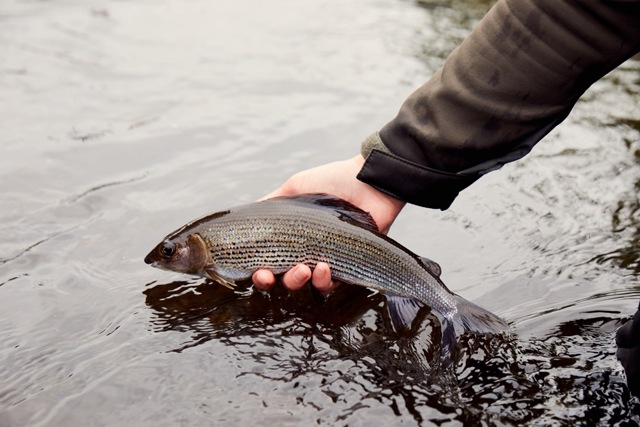
There were some new flies I’d tied up to try, and that always adds an extra sense of optimism. When I say “some” I really mean “two” fly patterns – a handful of heavy bead-head hare’s ear caddis patterns and then four pink-backed Czech nymphs, copied from a magazine article.
With a heavy caddis on the point and lighter nymph on a dropper I began to comb the water in the way that the fishing magazines said competition anglers approached grayling fishing. The sky was dull and the air was damp and cold – which all seemed suitably dramatic.
The water was quite clear (just a touch of colour in the deeper pools) and it was a real novelty to be out in the woods with beech leaves and frost carpeting the ground – and wading on the smooth cobbles in the cold water was kind of fun. The rhythm of casting the nymphs, tracking their drift as best I could and then kicking them up to the surface to cast again was actually turning out to feel very therapeutic.
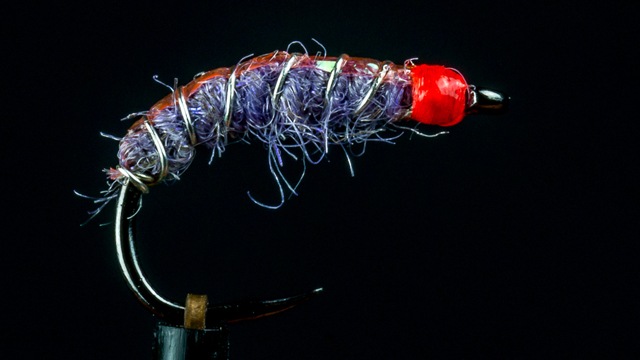
Then, perfectly unexpectedly, in the middle of one of those drifts the tip of the fly line flicked fractionally upstream. A tentative hookset was met with the rod bending (had I hooked the riverbed?) and then starting to nod rhythmically (no – this was definitely a fish).
I was delighted.
The fish had tilted up from the riverbed and taken hold of the pink-backed nymph and, looking in the net I experienced a definite buzz. It actually worked and there was no argument that the pewter-scaled flanks and colourful dorsal fin were incredibly beautiful. Because of that, I’ll always have a soft spot for grayling and also that specific section of river. It was a perfect cure for the mid-winter funk. Something well worth getting out of bed for. It is the obvious source of my grayling fishing addiction.
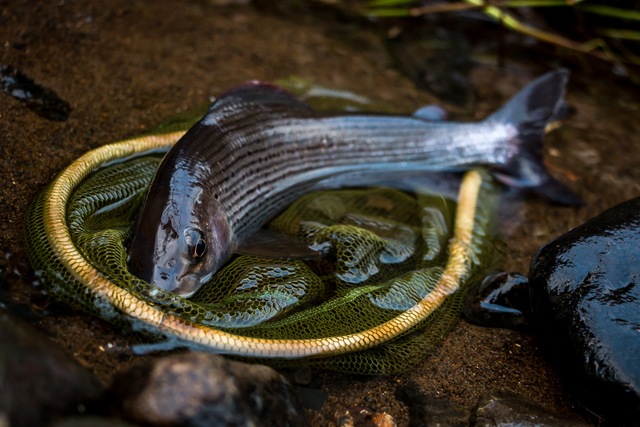
But I think the thing that actually cemented my affection for grayling fishing is the fact that they can be so massively moody. Some days, they are the most gullible and easy to catch fish in the world…Then other days, it’s as if there is not a single fish in the river.
And then there are the days that you can see them feeding and yet calmly refuse anything you care to throw at them.
It’s that chance of great catches – but the complete lack of a guarantee that they will co-operate – I think that makes fishing for grayling so habit-forming. Variable (and unpredictable) returns as the experts on addiction would say…
(Some of) The Grayling Fishing Books Don’t Work
Maybe I’ve not found the good ones, but the books I’ve read that are dedicated only to the habits of grayling as a species are nice to read, but really don’t unlock much of what the most successful anglers know about catching these fish. Instead, I’ve probably gained a better understanding of what makes grayling tick from books that are dedicated to, more general, competitive river fly fishing methods. Magazine articles from good anglers can also be a very effective way to improve your success with grayling fishing on-stream.
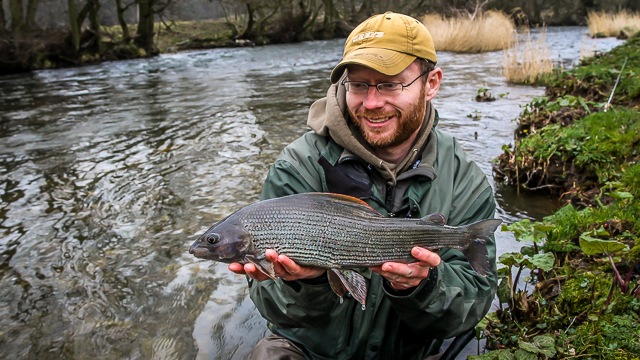
Of course, the greatest improvements come from spending time on stream with talented anglers, observing, asking questions and getting coaching where possible. This gives you brilliant raw material to go away and experiment with on your own.
While this is true, it isn’t always possible to hook up with people who really know the techniques inside and out. That’s basically the idea behind this article. I think probably the most amazing thing about the internet is the ability to take ideas, knowledge and skills and put them out into the world for anyone to pick up and use.
Grayling as a Target Species
It’s not just the attractive colours and proportions – but also the behaviour of grayling that make it a fascinating fish to go after. The willingness of grayling to feed down to incredibly cold temperatures is something that keeps many anglers (like me) from going stir crazy in winter months. At the same time, that maddening habit of just melting away and sulking can kick in at any time. Like I said, the easiest and most difficult fish all in one.
Of the two grayling species it is likely that the European grayling (Thymallus thymallus) has the larger following among anglers right now. As well as groups like the Grayling Society in the UK, there are a lot of magazine column inches devoted to the methods developed specifically for grayling by the most successful international competition river fly fishers.
Judging by my Facebook feed, Artic grayling (Thymallus arcticus arcticus) are also gaining a little bit of a niche fan base in some places in the USA – and it’s one on my bucket list because they are absolutely stunning fish. It’s important to say that these awesome fish are under threat – as George Wuerthner highlights in his article “The Sad Tale of Montana’s Artic Grayling”
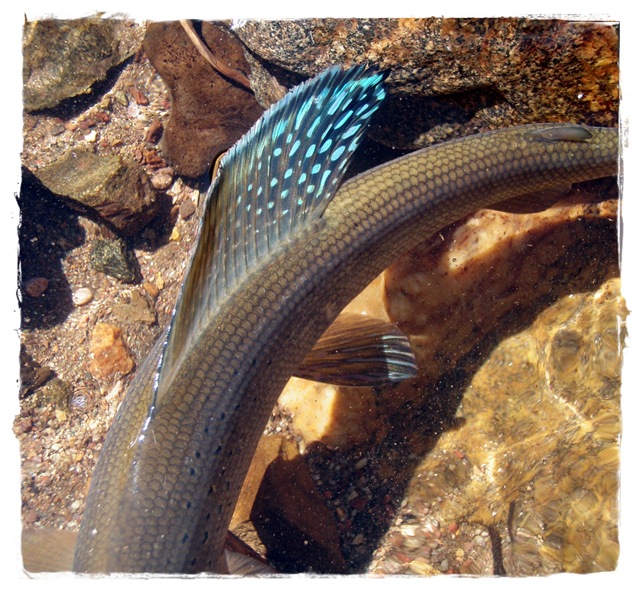
But just the fact that there are folks who are keen to identify themselves as grayling fishing fans shows we’ve come a long way from the dark history of grayling being treated as vermin on the chalkstreams of England. The now notorious Frank Sawyer pattern the “killer bug” was devised by the River Avon’s most famous river keeper as a way to efficiently remove those unwanted fish.
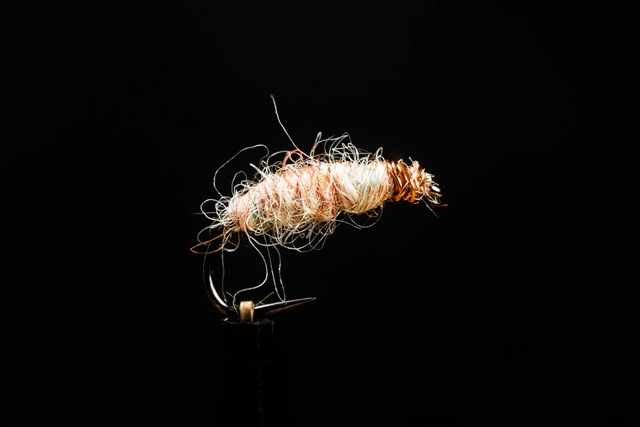
Thankfully, now grayling are actively welcomed on (most) chalkstreams and there’s a long-running appreciation of grayling on Wales, Northern England and Scotland’s rain-fed rivers. There are even chalkstream venues that run dedicated grayling fishing events and day tickets during the otherwise “slow trade” winter season. It’s fair to say that grayling are incredibly popular throughout their range in mainland Europe.
And the fan-base for grayling fishing is not restricted to the winter months. In fact the different behaviour of grayling between winter (when they tend to shoal up and use deeper/slower water in colder weather) and summer (when they get into more “streamy” water and hang out in way looser groups). In many ways, the shift towards more solitary habits and shallower water make summer grayling a totally different challenge from the winter sport
Grayling fishing techniques
Let’s get one thing straight…Some folks think that naming and recognising different tactics is “elitist” (which I’m told is a “bad thing”). I’m just not too sure on how that fits with me being a bait angler, fly fisher, sea angler, Czech nympher, French leader fisher, largemouth bass/finesse worm angler – all at the same time. For me, recognising that folks have put a ton of effort into developing great tactics just makes them even more enjoyable to learn about and use.
Basically, you should take what you want from this – I’m not here to tell you how you should fish; only how you CAN fish (and catch more than your fair share if you want to).
And if you do want to catch a few more fish than the average Joe, I’m here to tell you that is WAY easier if you’re able to recognise the differences between different methods and traditions. Overall, the best chance of appreciating the beauty in any technique – is to try all techniques if you have the opportunity. More on that later…
Because I need to keep things focused on what I can help you most with, this article will stick to running water and European grayling.
WARNING – KNOWLEDGE BOMB ALERT!
Before all the techniques that follow – if understand one simple idea; you’ll have a huge head start on everything:
Water tends to flow faster at the surface than at the river-bed (because, you know, friction and “science”).
When you put that one idea together with the fact that Grayling often like to hold near the riverbed (where the water is slower) then all the grayling fishing tactics in this article will fall easily into place.
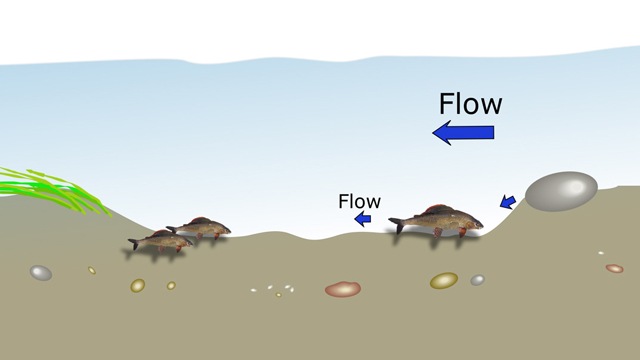
One final “primer” before getting stuck in to the tactics: Grayling tend to prefer even-pace of water and not “whorling” vortex currents or the more powerful flows. Despite what you might read, it is not true that they always prefer sitting next to the bank (or the middle of the river for that matter). They can be found anywhere that the pace of the current suits them – and especially where there is gravel (and double-especially where there is an increase in depth compared to the surrounding area). The general rule is that the colder the day, the slower and deeper the pools they will seek.
Pay particular attention to any “downslope” and “upslope” areas that defined the front and back edges of any slightly deeper feature in the stream (as shown in the diagram). Knowing those few things will give you a more than good enough head start.
Now, a rundown of tactics…
Trotting: Classic Winter Grayling Fishing
The “ever so British” method for winter grayling fishing outings. Here’s a basic rig that aims to get your bait to the lower third of the water column and carry it along at a natural and attractive pace.
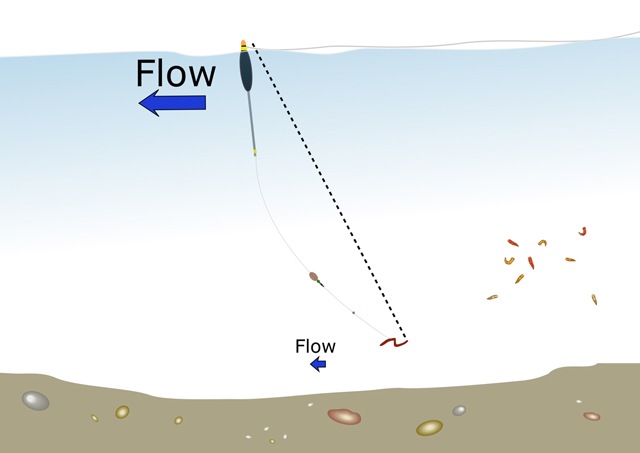
The use of a good quality free-spinning centre-pin trotting reel hugely enhances the pleasure of this method. Not only that, but anyone who goes to the trouble of learning both the “Nottingham Cast” and the “Wallis Cast” can justifiably sneer when anyone suggests that fly casting is more technical than bait fishing. There is nice step-by-step sequence to learning a Wallis cast here:
As well as choosing even-paced glides, you can improve your chances with this method simply because you are allowed to throw in some bait as free offerings of loose feed to attract fish. Key points:
You need to set the depth of the float (and the amount/position of weight) so that your bait will travel close to the riverbed.
NOTICE IN THE DIAGRAM HOW THE FLOAT TRAVELS AHEAD OF THE BAIT when allowed to drift perfectly naturally (this is what gives the “contact” between your hook and your indicator mechanism – in this case a float or bobber)
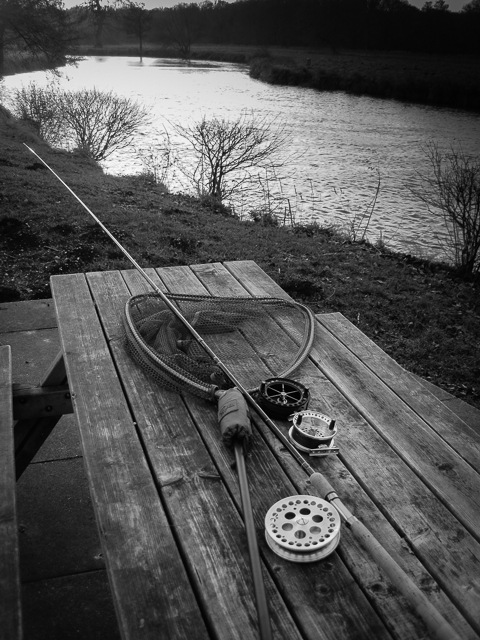
I would urge you to favour the use of worms (and larger hooks) until you get very practiced at keeping contact and detecting bites. At first there is a risk that maggots and small hooks can often be swallowed using this method (at least agree to change onto a larger bait and hook if you have one grayling swallow a small bait. The use of a “tell-tale” small shot very close to the hook is an essential aid to sensitive bite detection while grayling fishing with bait.
Cutting the line as close to the hook as possible is the best option if this unfortunately does happen to you. I would also advise going for a hook pattern that is designed to avoid being swallowed by the fish. As one example (and we have no connection with the makers/sellers) the Guru QM1 have a good reputation for being effective trotting hooks.
To get the best out of trotting when grayling fishing, make sure to take advantage of the special ninja-trick of braking the edge of the spool with your thumb from time to time…This is called “holding back” and it causes the line to tighten up between your rod tip and your float. The bait quickly overtakes the float (momentarily losing “contact” as it passes directly beneath the float)….But that contact is regained once the weight and bait start to strain against the main line with the float attached.
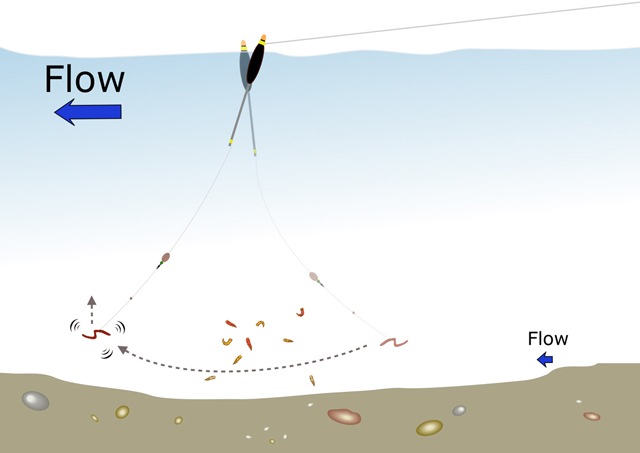
That tension causes the bait to flare up in the current and is a classic form of “induced take”. Expect previously unresponsive fish to grab hold at this point – so watch your float carefully and pay attention to what you can feel down the line too. The diagram shows the effect you are trying to produce when occasionally “holding back”.
Pole float fishing
Although “long trotting” as described above has the big advantages of throwing in loose feed to attract fish and the ability to naturally drift your bait for really impressive distances – it does have some drawbacks.
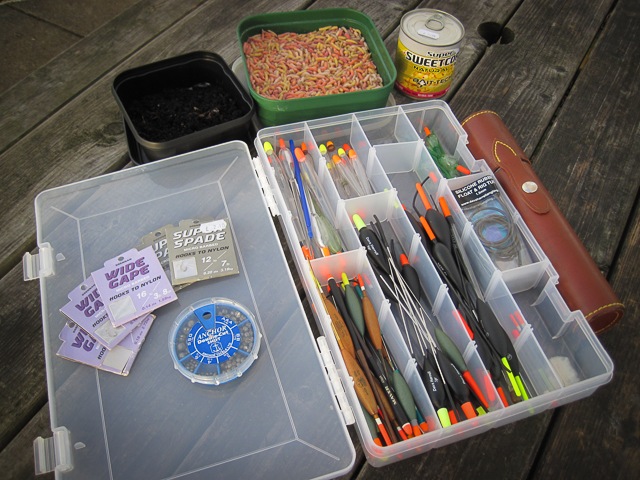
Sometimes the temptation to drift or “trot” your float over long range can act against you in two ways. Firstly it can dull the impact of your hook-set (as well as forcing you to crank fish over longer distances upstream against the flow). Secondly, if your control isn’t perfect and especially when using larger weights, you can lose some of the sensitivity needed to detect the particularly gentle bites of grayling in winter.
That is what can lead to deep hooking with smaller, soft live baits. When you miss the early, subtle “bite”, by the time your float does positively disappear, the grayling has already swallowed the hook.
Both of those effects are the result of your line laying on the water between your rod tip and your float. The stretch in the line and the “muffling” effect of the water on your line act together to dull sensitivity and hook-set ability.
Enter the uber-sensitive pole-float methods that were imported to Britain from Continental Europe in the late 1970’s and early 1980’s. These methods rely on long, “fixed line” (i.e. no reel) graphite rods that come in two basic types (known as “poles” or “whips”).
Poles are generally 10 to 14 m long and have a tensioned, elastic cord fitted inside the top three sections of the rod to cope with the runs of a strong fish. That elastic will stretch and extend outside the tip of the rod when a large fish pulls hard enough. Most of the sections (apart from the telescopic top three) of a pole are “put-over” joints. In other words, you fit them together by pushing the lower section (male) inside the upper section of the pole (female) at the joints between each section.
Whips are generally less than 7m long and are usually telescopic throughout their full length (they sometimes have one or two “put-over” joints at the butt end to extend their reach). They don’t have an internal elastic fitted.
The main advantages when grayling fishing by trotting with poles or whips are sensitivity and control. The fact that the line between the float and the rod tip can be held vertically off the water gives incredible “contact” as well as perfect tracking of the drift. It also allows you to hold-back and then continue drifting with minute degrees of control too.
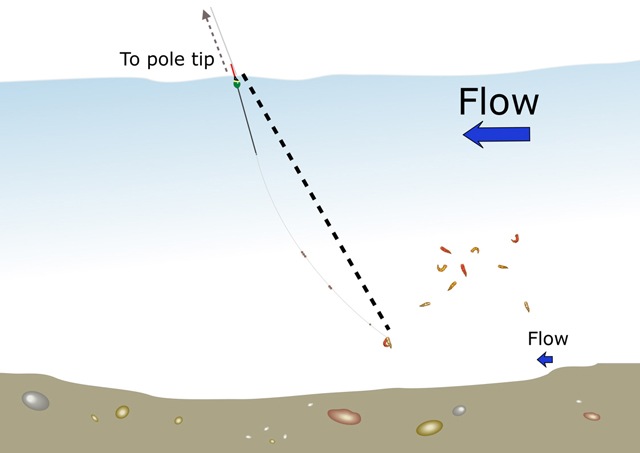
The fact that you don’t need a larger float or heavier weight to fish at longer range (you just need a longer pole!), means that you can tune your rig for ultimate sensitivity. However, you will, of course, need sufficient weight to take your bait down close to the river-bed.
There are a lot of subtle details to things like “shotting patterns” (how to space out the split shot weights beneath your float) that control how the bait falls through the water and how sensitively a bite is transmitted up to the float. I don’t have enough scope here to go into tremendous detail, but there is a lot of good information published on those tactics. A good place to start might be Pole fishing Magazine.
Again, notice that when naturally drifting (and not under the total tension created by “holding back”) your bite-detection relies on your float travelling downstream ahead of your bait. Yet again, this is naturally achieved – as long as your tracking of the drift with the rod tip is good – by the surface current travelling faster than the deeper layers of water.
Interestingly, when this weird reel-less method was first seen in the UK, it was dismissed as “foreign nonsense” that was no match for the existing methods. It didn’t take too many thrashings in competitions for the closed-minded folks to have to eat humble pie. As we’ll see that might be a bit of a pattern…for instance…
Czech nymphing: Mainstay Grayling Fishing Method for Fly Anglers
If you are a hard-core bait angler, you might want to skip ahead to the “Keiryu bait fishing” section. But if you fall into the bold all-rounder camp, I’m sure you’ll find lots to help you across many of your preferred methods here.
Czech nymphing (or closely related/entangled Polish nymphing) on a short line is another method that, when first seen in Britain, was dismissed as silly and irrelevant. But being pounded into oblivion by the Eastern European teams at the 1990 world fly fishing championship on British soil again forced a re-think once again. Looking back at an old video I did for the Wild Trout Trust, and skipping ahead to 30-seconds from the beginning, you can see how effective this method is:
While trotting methods are classically used as a winter grayling fishing approach, Czech nymphing can be equally good in winter and summer. The use of two or sometimes three flies on a tippet (generally spaced roughly 50 cm or 20” apart) allows several depth-bands of water to be covered. Most people think that because it is very simple, that it is easy and also lacks skill.
Those people would be wrong.
I use Czech nymphing as the very first Cornerstone of my river fly fishing tutorials. Without a deep and solid understanding of tracking, drift control and VISUAL detection of bites using this short-line method – it doesn’t make any sense to move on to any other tactics.
The flies used are
very simple (more on that later) and are designed to sink easily through
a combination of added weight and relatively streamlined profile.
The diagram below gives a basic sequence that you should aim to copy when learning to present Czech nymphs.
In the tutorials, I also cover the mistakes that almost everyone makes (while thinking that they are doing exactly what is shown in the diagram). When I say “mistakes” I don’t mean what the style police decide what is OK…I just mean the things that massively reduce your chances of catching fish.
The major (MAJOR) things to notice and understand are, yet again:
- You need to maintain “contact” between your rod tip and your point fly (the one on the very end of your line)
- Your rod tip and indicator should lead downstream ahead of your flies (you should watch the angle of your tippet as it cuts down through the water)
Try to copy the diagram as closely as possible and also to apply the tips on reading the water – and you will be a long way in front of most folks. That’s especially true when you couple it with the understanding that you are NOT feeling for bites…You are watching the coloured line for the slightest twitch before setting the hook.
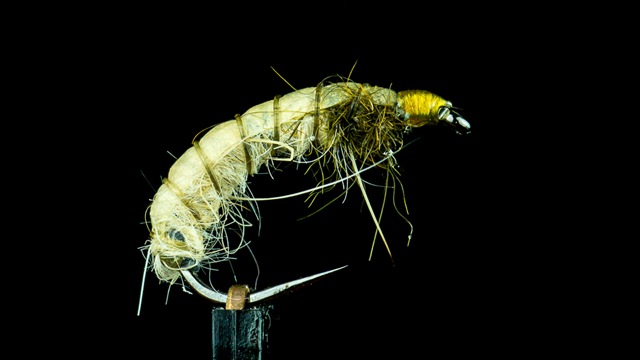
When you can’t get close enough to fish without spooking them (flat, low water – bright conditions, clear water and especially spooky fish), then Czech nymphing can be very difficult…Unless you are happy to lay face down in shallow water and inch yourself into position Native American style…Instead you might benefit from:
French nymphing
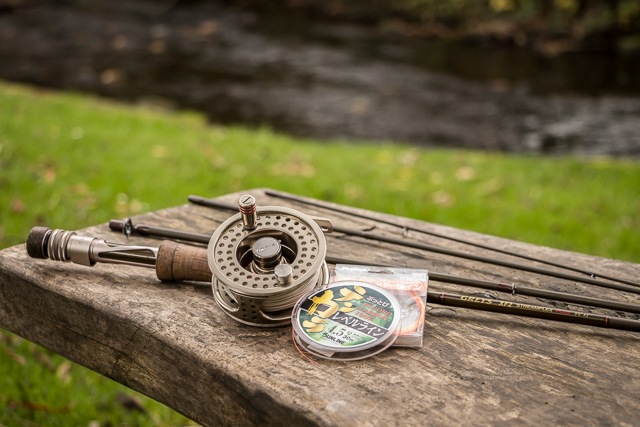
Fishing with competition-style “French Leaders” is another tactic that can be equally effective whether grayling fishing in summer or winter. Perhaps a good way to describe it simply is a way of producing an excellent, natural drift of slim, weighted nymphs – but with greater separation between the angler and the flies. Another important aspect is the ability to hold most or all of the “casting line” (originally a specially designed leader which is designed to cast like a very light fly line). The lightness – but good turnover right off the rod-tip – allows that leader to be cast like a fly-line and then (worth repeating) HELD OFF THE WATER well clear of nagging currents. It also avoids the “splashdown” that you get when fly-line lands on the water that can spook fish. Finally, because the casting line is free of the surface tension of the water, you get a better transmission of your hook-set motion right down to the business-end of the rig.
Unlike short-line Czech nymphing, using the longer French leader and presenting nymphs at greater range and with a high rod tip allows you to cast at any angle to the current…including directly upstream. With short-line nymphing – you need to face at least slightly across the stream and track with the rod closer to the water’s surface. If you tried to cast directly upstream with a short line, you’d simply hoist your flies vertically out of the water when you tried to track the drift! Instead, you’d need to pull more fly-line off your reel and fish more in the style of classic upstream nymphing…laying some fly line on the water. This removes many of the benefits of increased contact and sensitivity that you are looking for with short-line Czech nymphing. Those drawbacks are what gave the impetus to develop French leaders and the associated tactics.
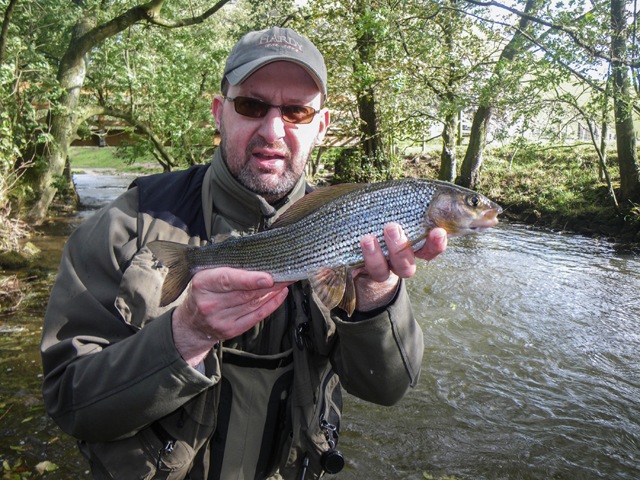
Again, there is a lot more to this technique than meets the eye – and a lot of lessons on reading the water as well as rigs and tactical tweaks are included in my free email tutorials (sign up form available on the Polish nymphing article linked above)
In its original form, French nymphing approaches (and related tactics developed in many Continental European countries) were used to present very delicate little nymphs (think a leaded underbody covered with tying thread about the size and shape of a grain of rice, with a few tail whisks made from hackle fibres projecting backwards). These nymphs were often presented singly (i.e. just one of them on the end of your tippet) in VERY spooky water to nervous fish in highly pressured rivers. Nowadays, similar tactics are often applied in slightly more forgiving conditions and with maybe a pair of nymphs (which could carry a bit more weight and bulk – in the form of tungsten beads – than the original patterns).
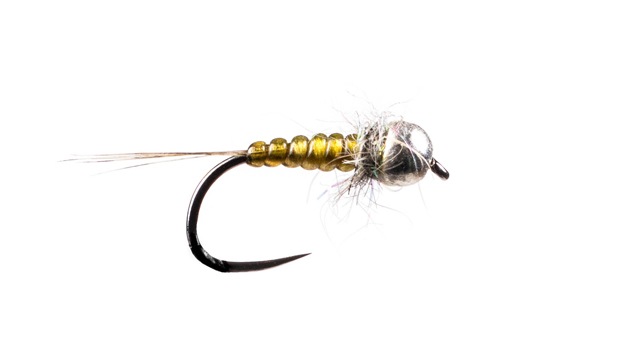
The heavier the nymphs, the less need there is for a specialised leader that will cast like a fly line! Do bear in mind that one of the beauties of a good French leader (or nylon tenkara line – more on that soon) is that they can be devastatingly effective for fishing dry flies to spooky fish…
For both Czech and French nymphing rigs, a very broad guide would be to mainly choose nymphs that resemble shrimp/scud and caddis grubs (most Czech nymphs for example) in the winter and then mainly patterns that resemble small mayfly/olive nymphs and caddis pupae in summer.
There is an incredibly focused “magic bullet” nymph-pattern AND fishing location selector tool included in the Fly Fishing Bible of Nymphing which also includes when and how to use tiny midge larva nymph patterns (versus caddis and shrimp)..It’s fair to say that the development of all Euro nymphing methods are strongly associated with grayling fishing.
Enter the Tenkara Rod
Both of the basic European Nymph fishing tactics (above) can be used with great success on a tenkara rod. Why would you do that? Well, right off the bat you can see that tenkara rods are generally significantly longer than even purpose-built Euro-nymphing fly rods. Most tenkara rods range between around 12 ft to 14 ft 9 in or 3.6 to 4.5m. In contrast, it is rare to find a nymphing rod longer than 11ft.
Secondly, when you add rod rings (line guides) to a blank, it puts a certain limit on how fine the tip of a rod can be without sagging (and it also affects the way that a rod “recovers” to a straight position after casting). Because tenkara rods have no guides, they can be made to cast incredibly light lines (or French leaders if you like) with better flexibility and recovery characteristics. This also makes them more sensitive – a key quality for detecting the often very shy bites encountered in grayling fishing.
Because of these characteristics, for most of my winter grayling fishing, I will use European nymphing tactics (to reach depth efficiently) BUT I’ll typically pair that with the greater reach, accuracy and sensitivity of a high quality tenkara rod. It is super important to recognise and understand that when fishing like this, you are Euro nymphing with a tenkara rod. Without any snobbery being involved towards either method – I promise you that it is important to your fishing to recognise the difference. The importance comes from two different directions:
- You will be much more successful if you clearly understand the differences (and similarities) between European nymphing and tenkara techniques
- The separate groups of folks who developed European nymphing and tenkara deserve recognition and respect for their work and traditions
I don’t hold with the idea that “well it’s all just fishing so I’m going to call it what I like”. Sorry, you don’t get to rewrite the history and wipe out the massive effort made by those folks. Mixing it all up and not allowing the important differences to be easily recognised is screwing over anyone who is new to either discipline who’d like to improve their understanding and technique.
There might be some folks who want to rain on your parade and put down the way that you fish. I’m not one of them. In fact, what I’m trying to do is expand your options on stream (not restrict them). But I will fiercely promote the benefits of recognising and naming distinct “schools” of fishing techniques…
At no time does this mean you are not free to fish using whatever (legal) methods you enjoy…that doesn’t harm anyone else’s chances or deny anyone’s work. Again, what does impact other people is to deny that there are any differences, options or advantages to tactics developed in different angling communities. That is basically the same as putting an Italian spaghetti and ragu into a bucket with a bowl of ramen and mixing them up with a spade…Well, it’s all noodles and sauce isn’t it? Having different restaurants is elitist! You’re only allowed to have one chain of restaurants and every one comes equipped with an industrial blender! Liquidised pizza curry paella anyone? You get where I’m going with this.
That’s not to say that there isn’t “fusion cooking” in fishing (especially between tenkara and European nymphing). There certainly is. But, just like in great cooking, the results are only worth a damn if you have a clear understanding of both schools in the mix. Right now there’s only a handful of folks who have got to a high enough level in both Euro nymphing and Japanese tenkara to really make valuable contributions and teach about the differences AND similarities (again please do experiment with both – but doing and teaching need to be separated out a bit is all I’m saying). In terms of having a deep understanding of both…Shin Takahashi is definitely one such person…
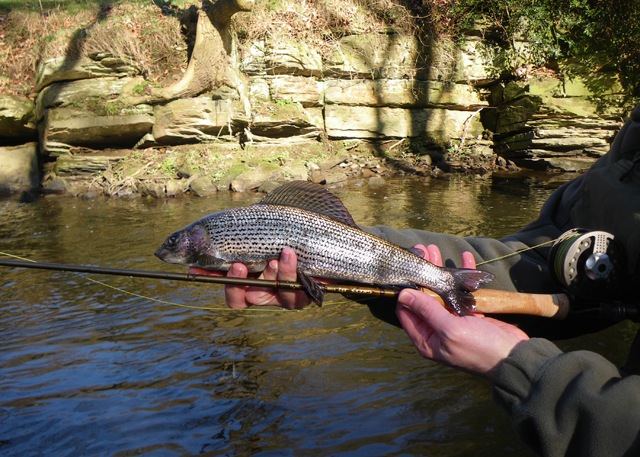
One of the most powerful things you can do as a “fusion” grayling fishing method is to combine Euro nymph patterns and rigs with quite sophisticated tenkara fly “manipulation” methods (Takahashi san has a great rig for that which we’ll cover in future media). Don’t forget, the best choice of rod could come from either tenkara or even Japanese “Keiryu” bait fishing (more on that below).
Takahashi san fishes a range of fusion tactics to great effect (as well as fishing straight up Japanese tenkara techniques, flies and rods to an elite level). A surprising “unfair advantage” you can gain in your grayling fishing is by checking out Takahashi-san’s on-stream masterclass of “tenkara nymphing” fundamentals that Shin Takahashi gave to a group attending a tenkara weekend festival in Itoshiro, Japan . As well as the video of his demonstration, there are several PDF downloads included which analyse his lesson and also give away his top (simple) nymph patterns. Everything he does in his demonstration would be incredibly effective when used to fish for grayling.
All of this is only possible to pass on and share with the whole angling community if we’ve got fairly accurate labels for the different ingredients. There, I’ve said my bit on respecting the life’s work of dedicated anglers from around the world (it’s about how we talk about it, not what you do/or do not do).
“Japanese” Tenkara, North Country Spider & “Valesesiana” tactics for grayling fishing
In the warmer months, using simple unweighted wet fly patterns from Japan and using presentation methods developed as part of Japanese tenkara skillsets is a very rewarding way to catch grayling. Before getting into tactics, I’ll get in a quick word on tenkara flies in Japan.
Most of them don’t have backwards/reverse hackles…
If that’s news to you, I’ve produced a detailed breakdown of Japanese Tenkara Flies that fills you in on how these flies are designed to “marry” to conditions and presentation methods. It also explains all about stiff-hackled WET flies and how reverse hackled flies are only a small part of the whole story (just click on the blue highlighted link above to read all about it). Now on to some comparisons of tactics…
You’d be forgiven for needing a solid definition of what I mean by “Japanese Tenkara” – so I strongly recommend that you read my Tenkara Lowdown so we’re both on the same page with what I mean! But tenkara is one of a group of traditional fishing techniques with a pretty strong family resemblence…
Apart from the more common use of multiple flies on a leader, the aesthetics and water craft for Tenkara shares a lot with that bastion of the British uplands – soft-hackle “spider” fishing. This has a long and deep association with grayling fishing on British upland rivers.
For the Historic British fishing methods and the flies I would have to recommend Robert Smith’s “The North Country Fly: Yorkshire’s Soft Hackle Tradition“. It is based on a vast amount of detective work into the (often private) “family lists” of flies used by generations of people who fished with these iconic patterns and methods. The fishing techniques and reading the water/presentation aspects are also a great introduction to this school of fly fishing too (and it is very far removed from the chalk-stream tradition, which can be surprising if you are an angler from outside the UK!).
Anyway, it is interesting that the approaches, presentations and also fly-designs (particularly when you see the old, original samples that are photographed in Smith’s book) do have quite a few similarities between tenkara and the North Country “soft hackle” traditions.
Perhaps this shouldn’t be a surprise. After all, the ancestral forms of “North Country Spider” fishing (and similar methods) would have come into the British Isles with the arrival of Catholic monks from the mountain regions of Continental Europe. In other words, incredibly similar rivers and mountains to those in which tenkara developed in Japan. As far as I know, there are at least five methods of fixed line/no reel fly fishing that are still practiced in small, isolated pockets in the mountains of Italy.
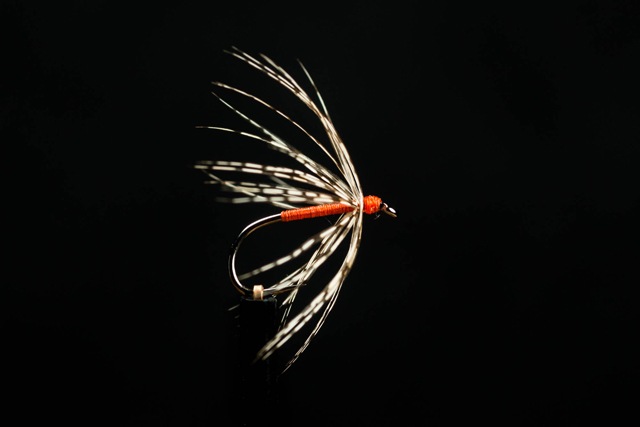
The most well-known of those is practiced in the Sesia valley and you can check out this site to find out more about “La Pesca a Mosca Valsesiana”. If you check out many of the fly patterns used in Sesia and similar regions, they do look an awful lot like your famous Snipe and purples, Waterhen Bloas and Orange Partridge patterns…and the European ones appear much earlier in the historical record than they do in the UK.
One thing to notice on the tenkara diagram below is that, just like all of the natural drift methods we’ve looked at so far…when you cast upstream, the rod tip/line (and therefore your “indicator system”) all travel downstream ahead of the hook. It is just the same as the “dotted line” angle that shows the sequence of all those components for trotting, pole-float fishing, Czech and French nymphing when using a natural drift presentation.
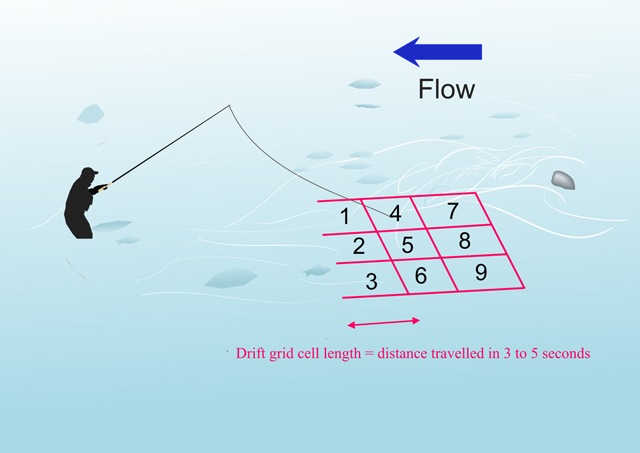
Like all the methods, it will take a bit of practice to get to grips with good and accurate casting for Japanese tenkara. There is also a very broad range of special presentation techniques and fly “manipulations” to learn if you want to get really good at it too. For information on how to start to develop good “Japanese” tenkara tactics that are so effective for grayling once the insects and the fish liven up a bit in the warmer months – please check out my “Expert Guide to Tenkara” pages on this site. It will save me repeating the information here and give you a great head start. I will say that it is a wonderful feeling to play and land grayling on the supple, long rods – with that “direct connection” of a fixed line…
Now to a very interesting method that (like “holding back” tactics when trotting) often breaks the rule of the indicator system leading downstream ahead of the hook. This is another bait fishing method, but one that you might never have heard of before…
Keiryu bait fishing

Although practiced with a fixed line rod in Japan – this is very different from tenkara. In many ways the most similar thing that we have in the UK would be the tradition of “gadger” fishing in Scottish rivers using live stonefly nymphs collected from the stream and drifted naturally – often cast upstream with a small weight on the line. There are also “gadger” fishing variations where fly rod and line (with a small wool marker attached to the tippet to indicate takes) would be fished.
But back to keiryu fishing…
The line used is much finer than the casting lines that are used to load a rod and generate a “fly casting loop” during tenkara fishing. Instead, very fine main line is used and one or more weights are attached to that line, close to the baited hook. Interestingly, just like the “gadger” fly fishers in Scotland – small tufts of wool or yarn are attached to the line above this weight to act as indicators.
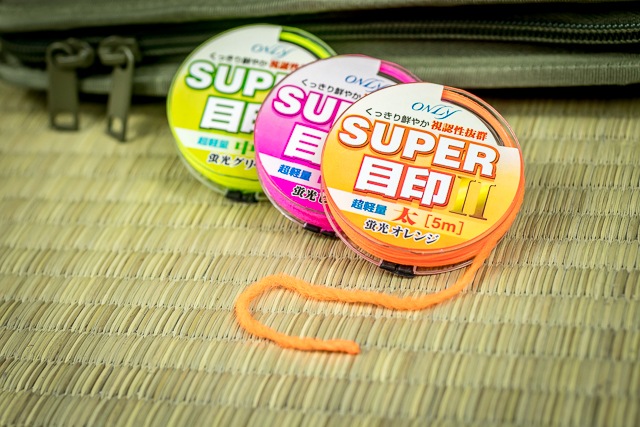
Here’s where it gets more like the coarse fishing “whip” methods that we mentioned above. The rods themselves are often in the 4.5 to 7m (14ft 9″ to 23ft)) range – but can be up to around 10m (>32ft) long. The line (and wool indicators) are not laid on the water. Instead they are held above it – a bit like the way that a Czech nymphing or French nymphing indicator is also (ideally) held off the water by the rod tip.
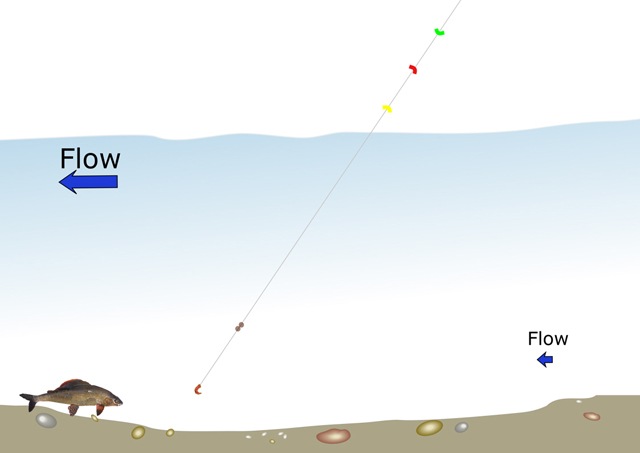
One of the core tactics that makes it a bit different from most of the things that I keep hammering home in this article – is how it breaks the rule of “indicator – then line – then hook” sequence. You see, many of the rivers in Japan are crystal clear and also fished by a lot of anglers. To combat this, the skilled keiryu bait fishers (like Choji Hosoyama – who sadly passed away in May 2017) will make sure that the very first thing a fish sees is the bait.
To do this, you need to make sure that the bait travels downstream ahead of your line, weight and rod-tip. This means that you need to drift the rig downstream after casting across the stream. By landing your cast roughly level with you where you are standing, you can then hold back a little bit with the rod tip to send your bait and weight downstream ahead of the rod.
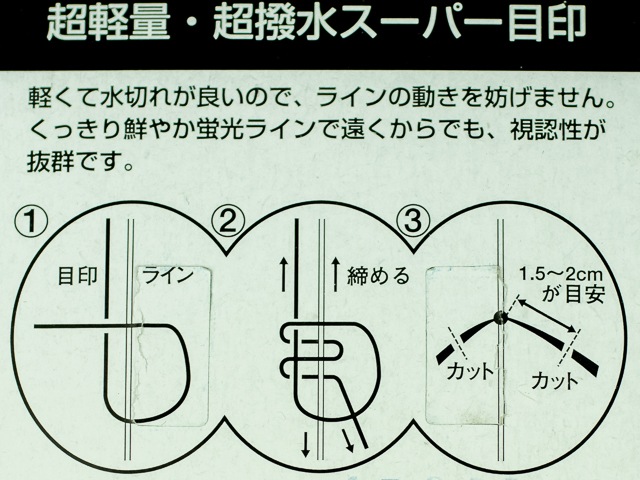
Crucially – this creates TENSION (in other words complete “contact”) between your rod tip and the hook. Now, by judging the angle of the line to make sure that your bait is getting deep, you can track downstream at the pace of the current. Any slight twitch of the yarn indicators is met with a swift hook-set and the tight “contact” makes this method very sensitive – so you SHOULD NOT be deep-hooking fish. As with trotting and other bait fishing, using a larger bait and mounting them on circle hooks (like Guru QM1 – available down to size 18) could be another layer of insurance against fish swallowing the hook.
Key learning point – that very same “bait first” presentation theory is also why so many top-level tenkara anglers on the harder-fished/more technically-demanding rivers in Japan practice so hard on their downstream presentations. Transferable skills and cross-training – that’s what it’s all about.
Back to keiryu bait fishing…In 2017 we were fascinated to watch traditional angler (and fishing shop owner) Hisanobu Hirata wading around large boulders in his local river to collect nymphs to use as bait. As well as keeping them in a box lined with damp, absorbent material, it was the way that he collected then which was remarkable. He had a damp “loofah” sponge (just like you’d use in the bath) and would gently rub that over the surface of the boulders underwater. Then – and this relies on having the very clean water that you find in Japanese mountain rivers – he’d delicately pick each nymph off the sponge with his mouth!
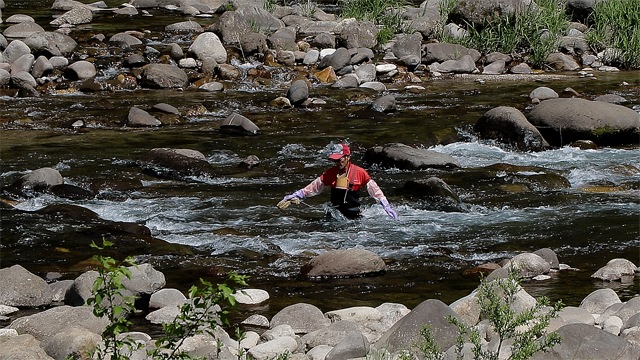
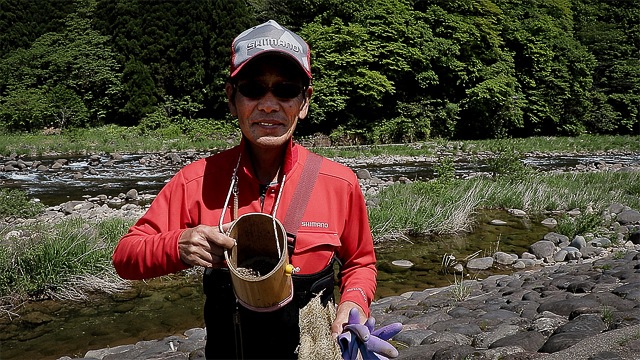
Quickly spitting each one into a little collecting box hanging just beneath his chin meant he didn’t risk crushing any of the delicate legs/tails of the nymphs. That way, they’d stay healthy until it was time to use them. I wouldn’t advise that in the “post industrial” or actually any other rivers that I often fish for grayling in the UK!!
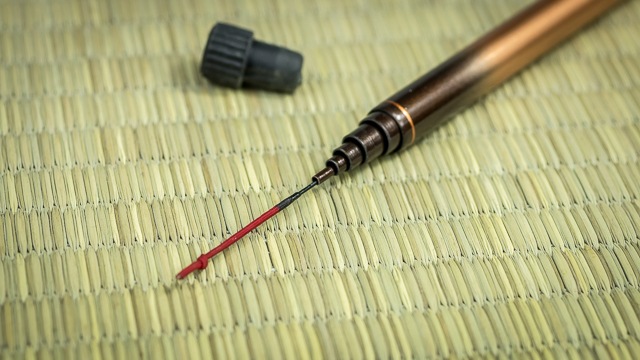
In terms of rods, I dare say that a high quality 5 to 7-m whip would make a very good keiryu bait fishing rod to try your hand at the method. If you find that you like it, there are an increasing number of rods becoming available in the West – and TenkaraBum in the USA has quite an impressive range.
Here’s an example of the tactics in use in Japan (note that fish that size in flow that is as powerful as the rivers shown provide a very strong fight):
Dry fly
It seems strange that it has taken me this long to get around to mentioning the classic method that so many grayling anglers are addicted to. Although it is most often used as a summer method of grayling fishing, dry flies can be a wonderful method any time there is a hatch. Even in winter there will be the occasional midge (or even olive) hatch and some fly fishers take pride in catching at least one fish on a dry fly in every month of the year.
Unlike trout, grayling often rise repeatedly to the same fly – even if you miss your hook-set.
As you’ll see below in the “grayling flies” section, there are one or two patterns that people particularly associate with grayling. But one thing that can really set your success apart when fishing dry flies for grayling is (where the rules allow) is to cast downstream to them.
On top of tapping into the very same effect as keiryu “bait first” presentations (see “cross training” again – that’s why it’s cool to get into lots of different methods and not be a purist snob) – it also takes advantage of the way grayling tend to grab hold of a fly.
Here’s a VERY old piece of footage that was taken using my very first amateur camera when me and JP were on a trip to the Czech Republic. Despite the limited quality of the video image, it definitely shows how effective fishing a downstream dry fly can be for grayling!
Because grayling’s mouths are on the underside of their heads, they have to tilt up at a very steep angle to grab a fly that is floating on the surface. When they do this, they often “roll” back downstream after they take a fly into their mouth. That means it isn’t unusual for them to be facing downstream by the time you try to set your hook. If you’ve cast upstream to the rising fish, that almost always results in pulling the fly out of a grayling’s mouth. When you cast downstream, you often get the advantage of the fish facing away from you as you set the hook.
Grayling Fishing tactics round up
Perhaps when I get round to updating this article, I’ll look to include some content on methods like light spinning and even tiny streamer flies that some folks find effective and enjoyable. But for now, I want to leave the grayling fishing techniques section with an observation that should help you to have more success with any and all the tactics I’ve described so far. Once you understand the effect of faster surface flow, the other main round-up point that you should take away is this:
Grayling, in my experience, seem to USUALLY prefer bait or flies that travel downstream in a straight line.
At least a straight line when viewed from above! I’m not talking about induced takes, holding back or any manipulations that move the fly or bait vertically. Instead I mean whether what you are asking a grayling to eat is moving laterally across the flow. Their reaction is usually very different from a trout’s when it comes to this.
So, for all kinds of reasons, swinging something on a tight line and low rod is generally the LEAST effective presentation when it comes to grayling fishing. That is true of trotting, it is true of dry flies and it is true of nymphs. Almost always, you’ll be better off getting your offering to travel down in line with the current.
Grayling flies
In Yorkshire, as I alluded to above, fishing the “North Country Spider” is almost a religion – and it does have something of an association with grayling for many folks. Again, I would have to defer to Robert Smith’s book when it comes to those patterns – because the photos in it are excellent, the collation of historic records and specimens (as well as controversially challenging a lot of the conventional wisdom – Smith and his book have certainly provoked strong reactions) are not really matched in any other publication that I’ve seen.
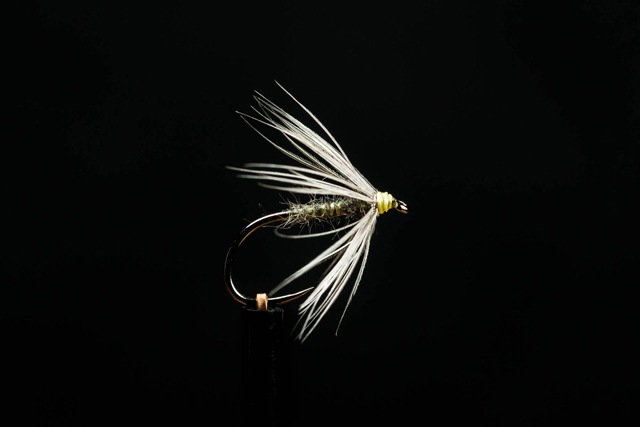
When it comes to grayling dry flies – there does seem to be a particular fondness for patterns with peacock herl bodies such as the classic Sturdy’s Fancy – shown in this picture from Richard Ward’s dryflyexpert.co.uk
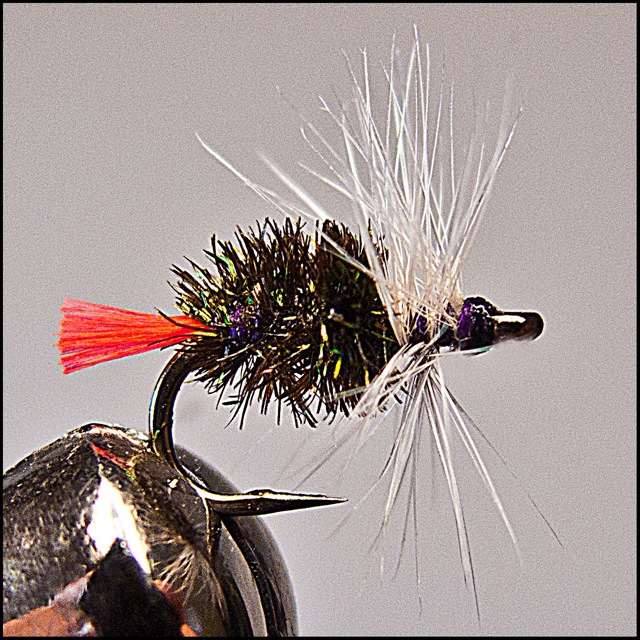
You can probably see a bit of a theme developing with the dry flies that are famous for being seducers of grayling (something to do with peacock herl maybe???) when you look at the Red Tag and Treacle Parkin patterns tied and photographed by Robert Smith below:
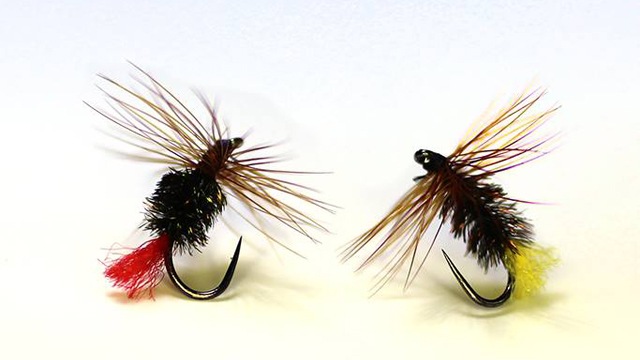
And those flamboyant tastes seem to extend to very large dry flies that can persuade a bigger grayling to leave the lazy comfort of the riverbed (such as the now infamous Klinkhåmer special – which also comes in shocking purple variant versions these days too!)…But what about grayling nymphs?
As mentioned at the beginning of this article, Frank Sawyer’s killer bug is a wonderfully simple and effective fly – the pinkish brown translucency of the original Chadwick’s 477 wool gave it a very juicy look. I must, though, give credit to the Utah Tenkara Guides LLC for finding Shetland Spindrift “oyster” yarn as a body material replacement for the discontinued Chadwicks 477. The Shetland Spindrift must be every bit as effective as Chadwicks and a fantastic tweak that the Tenkara Guides made was to replace the regular copper coloured wire with pink UTC. This is a GREAT fly for grayling fishing – particularly during the winter.
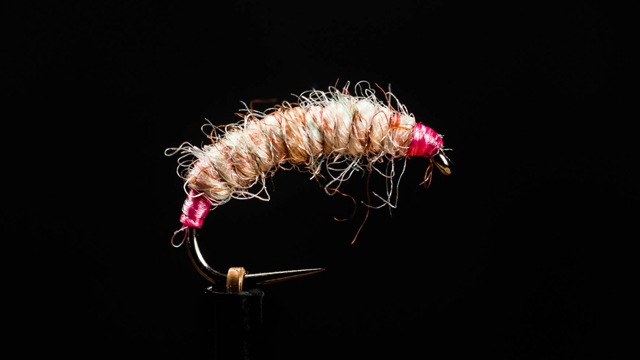
In reality of course – there is no such thing as a truly “grayling specific fly” – if it is recognised as the food of the moment; then it will be taken greedily. One thing that can TRICK you into thinking that there are separate “grayling flies” and “trout flies” is that within one particular day; grayling and trout can have different preferences. Sometimes, those preferences happen often enough that you can make a broad rule for that river at certain times of year…
For example, several people that I’ve spoken to about fishing on the Welsh Dee – flies that have tails often = “trout”. Whereas very similar flies that do not have tails = grayling. In actual fact, small, black “grub” style patterns with a bead head seem to be extremely effective for grayling on the Dee (and I’ve also noticed the grayling there feeding a lot on small, dark-coloured snails – which might not be a complete coincidence).
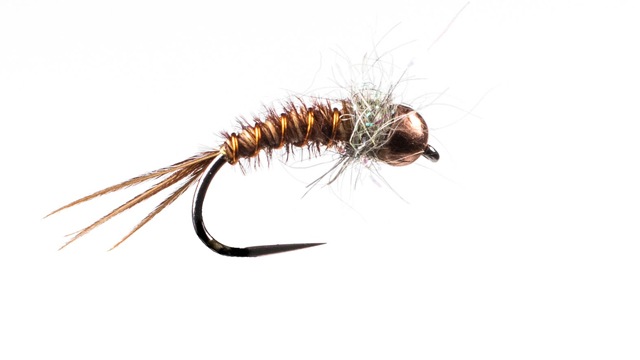
On rivers that I fish more often than the Dee, like the Derbyshire Wye and South Yorks. Don – you can often find a split between “shrimp” versus “olives” on some winter days when both types of prey are active. So that fishing with tail-less shrimp patterns means you catch exclusively grayling, whereas trying a pheasant tail or olive bead-head nymph (both with coq-de-lyon tails) results in being “bothered” by out of season trout…And yet, by fishing on those rivers more regularly, you will also see that preference reversed on a different day! Be careful about generalising hard and fast “rules” in fishing.
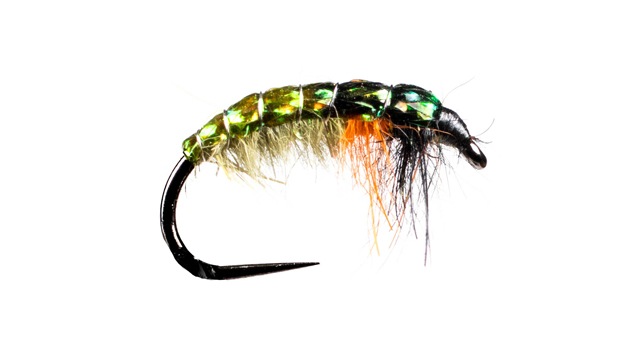
Brace yourself for “Paul’s Wild Stab at Some Biological Science”…The times when grayling and trout seem to be caught on different patterns probably comes from some aspect of what is known as “niche separation”. This is pretty much like what happens in the business world, if you have two companies trying to do exactly the same thing (in exactly the same niche), one of them – and maybe both of them – will suffer by competing with each other over the same small piece of pie. If, instead, they both go after two completely different pies – then there’s a better chance that they can eat their own entire pie all on their own.
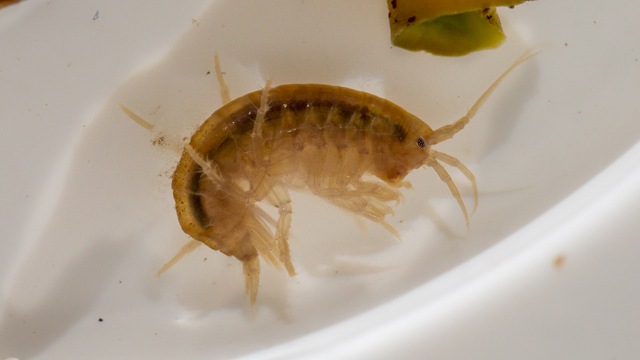
By choosing things like different parts of the river – maybe feeding in a deeper or shallower layer of water, or a different pace of current – trout and grayling can avoid fighting over the same piece of pie. The same goes for targeting different prey species – which could even be simply a natural consequence of where/how the fish are feeding. In other words, if both the shrimp and the grayling are hanging out in the deeper/slower water – what do you think those grayling will be eating? At the same time, the shallower water running off the back of a riffle with some helpless olive nymphs being washed along in midwater…If that’s where the trout are sitting, then that’s what they’ll be eating too.
What does this mean for the idea of “grayling flies”?
Well, if trout are out of season and you’re catching lots of them….Have a look to see what else is available for them to eat. If the trout are on olives, the grayling may be on shrimp – and vice versa; so make your fly choices based on that. You can also pay attention to the depth at which you are catching either species – and then make sure your flies are getting you to the depth that will select grayling over trout (whatever that depth is on the day).
Always remember that those “tails” or other bits of hackle on the nymphs that seem to be catching trout could just be stopping your nymph from sinking as quickly as flies with fewer “sticking out bits”. Those flies could also just be tied on different gauges of wire hook – which could also affect the sink rate.
Whether it is what the fly looks like or how the dressing affects how it sinks, you only need to try to find out if the grayling seem to prefer one style over another! Experiment and be ready to move away from an area if you hook more than one trout in a particular spot. There is no excuse for standing over out of season fish and catching one after another.
One thought I will finish this section with though is (especially in winter) grayling do seem to be prone to suddenly becoming really strongly attracted to certain colours of fly. That colour preference can be much stronger than anything you tend to see in trout in my part of the world. I go into some detail about something called “Super Normal Stimuli” in the book “How to Fool Fish With Simple Flies”, so I’ll try to avoid repeating myself again too much here.
Where to go Grayling Fishing
UK Grayling Fishing Venues
- You can find some of the finest big specimens of grayling on the River Dove in Staffordshire available on a day ticket (Google “Isaac Walton Hotel grayling day tickets”).
- River Frome, Dorset (some water available at a price on a day basis via Google)
- Timsbury on the RiverTest (Google “Timsbury Fishing”)
BUT probably the very best (and most social) way to get your grayling fix in your area is to join the Grayling Society
For your urban grayling fix, a great approach is to get in contact with (and join in on working parties with) the groups featured in Theo Pike’s “Trout in Dirty Places”.
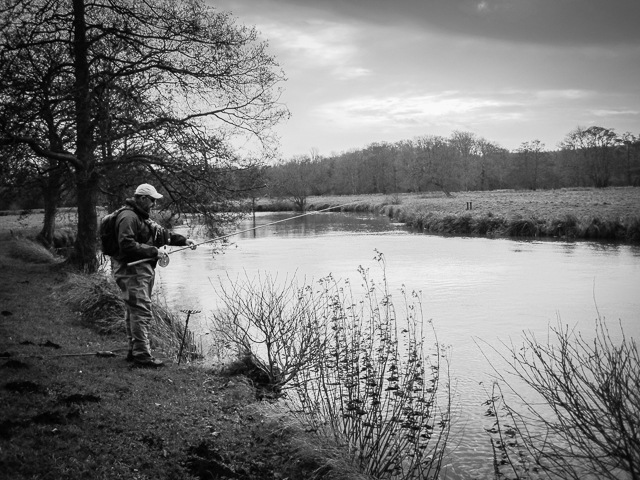
Grayling Rivers of the North American Continent
- Leaving aside Alaska and especially the Western Provinces of Canada, the most significant remaining true river system in the Lower 48 with native Arctic grayling is in Montana. There you might find a couple of pockets of grayling in the Madison Valley like a 60-mile stretch of the Big Hole and short section of the Madison near Ennis. This still represents around a 90% decline from previous distribution of populations there.
- In Utah, it is possible to find grayling in some lakes and Colorado is known to have populations in some reservoirs. On occasion the inlets/outlets associated with reservoirs mean that you can catch grayling in a flowing stream. Joe Wright reservoir in Colorado is an example of that (which is where Anthony Naples’ photo at the top of this article came from).
- But for the most comprehensive description of Arctic Grayling (and all other varieties too!) Check out this amazing post from Back Country Chronicles.
Over time I hope to add to this section and also update the main content with new and improved ideas…but for the time being, that about wraps it up…
Now, if you’ve learned anything new or enjoyed any of this article – please use the social share buttons on this page to let your friends in on the act too.
Please let me know in the comments below if you find any other better page on grayling fishing and I will try to improve this one to at least match it!
Paul

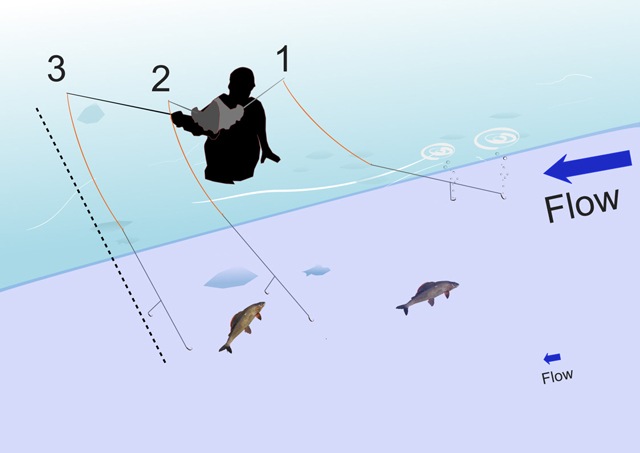
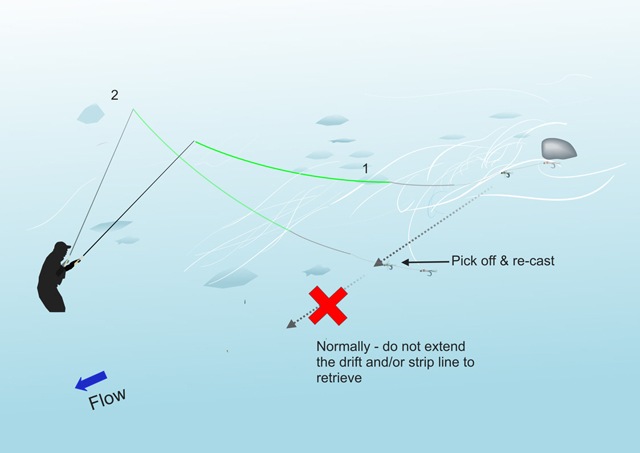
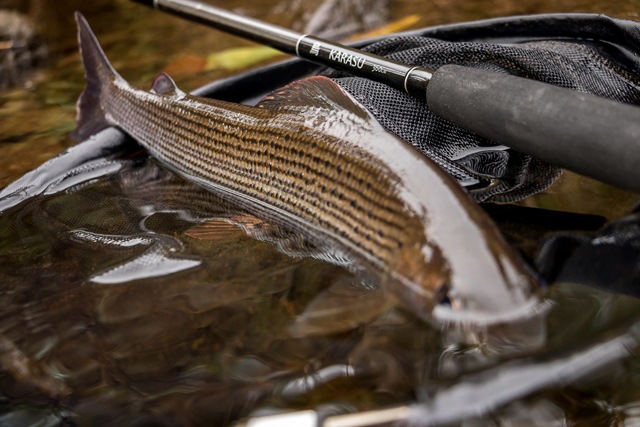
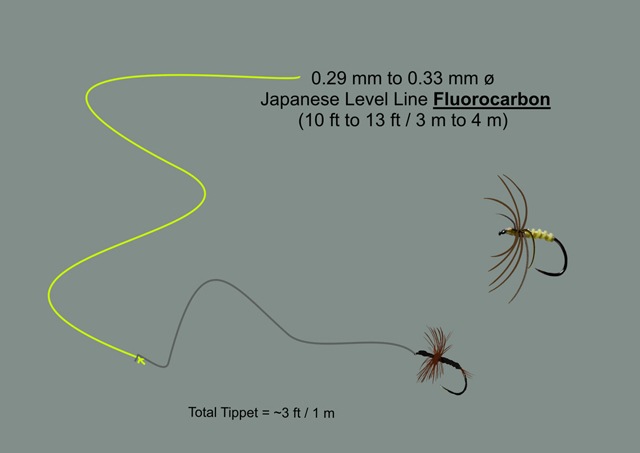
As ever, a great article. Must take ages to put together. Well done Paul and “Thank You”.
Many thanks Ian! You are very welcome.
Paul
Great to read such a comprehensive account of how the various disciplines all have their place and individual skillsets when properly employed. Lots of ideas to consider there, thanks for that breath of fresh air !
Big Thanks Dennis. I’m really happy that you enjoyed this one.
Paul
Brilliant as always, informative, thought provoking and to the point. Interesting videos and photos.
Big thanks Peter, you really are very kind!
Paul
Terrific article Paul, plenty there to think about, very informative thank you.
Tony, I hope there might be a trick or two you get to use in Derbyshire before the trout season 🙂
Many thanks Paul! That’s a thorough eye opener for me!
Thank you Charlie, it’s good to know that there’s occasionally a use for the stuff rattling round inside my head…:)
I have almost forgotten the last time the Tone was fishable! This article was the next best thing!
Hang in there Mark, maybe Devon is in for some better weather soon??
Thanks for a wonderful article. I’ve yet to fish for grayling. This article provides incentive to visit Joe Wright Reservoir.
Mark. Pics please if you get up there and have some success!
Interesant,educativ si de tinut minte,multumiri Paul,astept si alte articole …cu respect .
mulțumesc foarte mult Constanti:)
Really interesting article, Paul, many thanks for sharing it. I’ve also noticed that on the few times I’ve fished the Welsh Dee that all black Czech Nymphs out-fish all other patterns. On a slightly technical note, please ask your subscribers to check their ‘Promotions’ section if they are using Gmail for your emails – the email prompt for this article ended up in mine for the first time so I’ve just seen it!
Aha good point Carl, there is a constant battle for ‘deliverability’ of multiple recipient emails. A lot of it depends on you constantly opening and interacting with each email. You should also ‘whitelist’ my sender’s address.
Thanks Paul, great article well written and presented. Thoroughly enjoyed
Thank you Karl, I’m really glad you liked it.
Paul
Spitting the nymphs you have collected with a loofah into your bait box; now that’s what I like to hear. There’ll be more about him to come hopefully?
Christopher, my apologies for a delayed response, but yes there’ll definitely be more to come from Hirata-san:)
Living in western Canada, Alberta, we head up north to the rivers that flow into the Arctic Ocean for our Arctic Grayling fishing. Truly a beautiful looking fish and so fun to catch. Our province is now all catch and release. The size of some of the fish you show are rare here. They will exist much farther north in the less heavily fished rivers.
That’s interesting Terry, I’d always kind of assumed that grayling in Alberta would be bigger than most of our European ones. Regardless of size, I’d love to catch one with the cobalt blue in the dorsal fins – just stunning…One day!